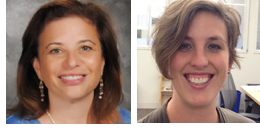Analyzing Authentic Data in a New Biostatistics Course for High School Students
From Sandra Haupt and Sara Kiesselbach
 Two years ago as colleagues in the math department at Concord Carlisle High School, we discovered that we shared a common interest in the field of Biostatistics. We have complementary strengths. Sara has a background in statistics, economics, applied mathematics and technology. Sandra has a background in science, math, environmental law, and public policy. Drawing on our respective backgrounds, we created an interdisciplinary, unleveled course focusing on three major areas within Biostatistics: Public Health and Epidemiology, Bioinformatics and Biodiversity. Unaware of any other high school Biostatistics courses and without a textbook, we contacted researchers in academia and industry to get authentic data sets for our students to analyze. Two years ago as colleagues in the math department at Concord Carlisle High School, we discovered that we shared a common interest in the field of Biostatistics. We have complementary strengths. Sara has a background in statistics, economics, applied mathematics and technology. Sandra has a background in science, math, environmental law, and public policy. Drawing on our respective backgrounds, we created an interdisciplinary, unleveled course focusing on three major areas within Biostatistics: Public Health and Epidemiology, Bioinformatics and Biodiversity. Unaware of any other high school Biostatistics courses and without a textbook, we contacted researchers in academia and industry to get authentic data sets for our students to analyze.
Our students analyze classic epidemiological studies from Doll and Hill’s seminal study on smoking and cancer to the Framingham Heart Study. Students use the FHS data to find links between health related variables of their choice. For example, students are able to conclude that there is a statistically significant relationship between type 2 diabetes and heart disease. Also, thanks to the Broad Institute of MIT and Harvard, our students are exposed to cutting edge data evaluating targeted gene therapy and cancer research, as well as data analyzing mutations in the Ebola virus.
We also initiated a biodiversity unit studying local flora (forestry data) and fauna (Blanding’s Turtle) thanks to data from Grassroots Wildlife Conservation. One of the themes in our course is thinking both locally and globally. This past summer with a grant from the Concord Ed Fund, we travelled to Quintana Roo, Mexico with Dan Bisaccio from Brown University. We collected and analyzed data as scientists, using the Smithsonian Institution’s Monitoring and Assessment Biodiversity Research protocols. We now have an enhanced background to teach our students the importance of understanding data in context, and to help them formulate questions about how, where, when and why the data was collected.
While in Mexico we gathered global endangered species data that can be used to compare to local endangered species data. This allows students to compare two geographically distinct areas while exploring connections to common global variables (i.e., government expenditures, climate data). We strongly believe it is important to include contributions of diverse cultures in science and mathematics. Our experience in Quintana Roo was enhanced by staying in open palapas in a traditional Mayan village, and that cultural context was important to us.
We hope to return next year with students to continue this longitudinal study. The mission of our school district is to educate all students to become lifelong learners, creative thinkers, caring citizens and responsible contributors in our increasingly diverse global society. Giving our students this research opportunity ties nicely into the theme of the Biostatistics course and to the mission of our incredible school district.
Sandra Haupt and Sara Kiesselbach are math teachers at Concord Carlisle High School in Concord, MA.
Back to newsletter |